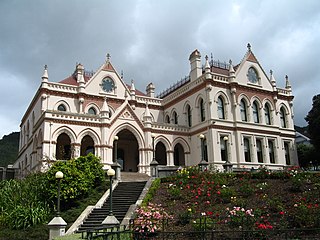Related Research Articles

Landscape architecture is the design of outdoor areas, landmarks, and structures to achieve environmental, social-behavioural, or aesthetic outcomes. It involves the systematic design and general engineering of various structures for construction and human use, investigation of existing social, ecological, and soil conditions and processes in the landscape, and the design of other interventions that will produce desired outcomes. The scope of the profession is broad and can be subdivided into several sub-categories including professional or licensed landscape architects who are regulated by governmental agencies and possess the expertise to design a wide range of structures and landforms for human use; landscape design which is not a licensed profession; site planning; stormwater management; erosion control; environmental restoration; parks, recreation and urban planning; visual resource management; green infrastructure planning and provision; and private estate and residence landscape master planning and design; all at varying scales of design, planning and management. A practitioner in the profession of landscape architecture may be called a landscape architect, however in jurisdictions where professional licenses are required it is often only those who possess a landscape architect license who can be called a landscape architect.
Regulation and licensure in engineering is established by various jurisdictions of the world to encourage life, public welfare, safety, well-being, then environment and other interests of the general public and to define the licensure process through which an engineer becomes licensed to practice engineering and to provide engineering professional services and engineered product to the public.

The Architects Registration Board (ARB) is the statutory body for the registration of architects in the United Kingdom. It operates under the Architects Act 1997 as amended, a consolidating Act. It began under the Architects (Registration) Act, 1931 which gave it the name the Architects' Registration Council of the United Kingdom (ARCUK). It prescribes architectural qualifications, maintains the Register of Architects, issues a code of professional conduct and competence and imposes sanctions if a finding of unacceptable professional conduct or serious professional incompetence is made against an architect. Its main source of income is fees payable under Part II of the Act by persons on their becoming registered or for their retention on the Register. The board is required to pay into the Consolidated Fund of the United Kingdom any sum paid under a penalty order which its Professional Conduct Committee has made under Part III of the Act. Fines imposed by a magistrates' court under Part IV of the Act are not payable to the board.

A driving test is a procedure designed to test a person's ability to drive a motor vehicle. It exists in various forms worldwide, and is often a requirement to obtain a driver's license. A driving test generally consists of one or two parts: the practical test, called a road test, used to assess a person's driving ability under normal operating conditions, and/or a written or oral test to confirm a person's knowledge of driving and relevant rules and laws.
Torrens title is a land registration and land transfer system, in which a state creates and maintains a register of land holdings, which serves as the conclusive evidence of title of the person recorded on the register as the proprietor (owner), and of all other interests recorded on the register.

Gordon Frank Copeland was a New Zealand politician who served as a Member of Parliament from 2002 to 2008. He entered the House of Representatives as a list MP for the United Future New Zealand Party from 2002 but he resigned from the party in 2007. In March 2009, Copeland became Party President of The Kiwi Party, which he had co-founded with another former United Future list MP, Larry Baldock, in May 2007. Copeland stood for the Conservative Party in the 2011 New Zealand general election. Prior to entering Parliament he held a number of corporate positions before working as the financial administrator for the Roman Catholic Archdiocese of Wellington.

The Office of Film and Literature Classification, branded as the Classification Office, is an independent Crown entity established under Films, Videos, and Publications Classification Act 1993 responsible for censorship and classification of publications in New Zealand. A "publication" is defined broadly to be any thing that shows an image, representation, sign, statement, or word. This includes films, video games, books, magazines, CDs, T-shirts, street signs, jigsaw puzzles, drink cans, and slogans on campervans. The Chief Censor, Caroline Flora, is the chair of the Office.

The Federal Insecticide, Fungicide, and Rodenticide Act (FIFRA) is a United States federal law that set up the basic U.S. system of pesticide regulation to protect applicators, consumers, and the environment. It is administered and regulated by the United States Environmental Protection Agency (EPA) and the appropriate environmental agencies of the respective states. FIFRA has undergone several important amendments since its inception. A significant revision in 1972 by the Federal Environmental Pesticide Control Act (FEPCA) and several others have expanded EPA's present authority to oversee the sales and use of pesticides with emphasis on the preservation of human health and protection of the environment by "(1) strengthening the registration process by shifting the burden of proof to the chemical manufacturer, (2) enforcing compliance against banned and unregistered products, and (3) promulgating the regulatory framework missing from the original law".

Engineering New Zealand Te Ao Rangahau is a not-for-profit professional body that promotes the integrity and interests of members, the profession, and the industry. It seeks to "bring engineering to life" and has more than 20,000 members.
Land registration is any of various systems by which matters concerning ownership, possession, or other rights in land are formally recorded to provide evidence of title, facilitate transactions, and prevent unlawful disposal. The information recorded and the protection provided by land registration varies widely by jurisdiction.
The architecture of New Zealand, though influenced by various cultures, expresses pre-dominantly European styles. Polynesian influences emerge in some areas.

The Architects (Registration) Acts, 1931 to 1938 is the statutory citation for three Acts of the United Kingdom Parliament, namely:

The Architects Act 1997 is the consolidating Act of the Parliament of the United Kingdom for the keeping and publishing of the statutory Register of Architects by the Architects Registration Board. It has the long title: An Act to consolidate the enactments relating to architects. It consolidated two Acts of the 1930s as later amended both by primary legislation and by Orders in Council implementing the EC directive on architects providing for the recognition of architects qualified in other EC states, and the changes which had been made by Part III of the Housing Grants, Construction and Regeneration Act 1996.

A building engineer is recognised as being expert in the use of technology for the design, construction, assessment and maintenance of the built environment. Commercial Building Engineers are concerned with the planning, design, construction, operation, renovation, and maintenance of buildings, as well as with their impacts on the surrounding environment.
The gun laws of New Zealand are contained in the Arms Act 1983 statute, which includes multiple amendments including those that were passed subsequent to the 1990 Aramoana massacre and the 2019 Christchurch mosque shootings.
An urban planner is a professional who practices in the field of town planning, urban planning or city planning.
In the United Kingdom, the Architects Act 1997 imposes restrictions on the use of the name, style or title "architect" in connection with a business or a professional practice, and for that purpose requires a statutory Register of Architects to be maintained. The Architects Registration Board constituted under the Act is responsible for Architects Registration in the United Kingdom and is required to publish the current version of the Register annually. Every person who is entitled to be registered under the Act has the right to be entered in the Register. The Act consolidated previous enactments originating with the Architects (Registration) Act, 1931 as amended by the Architects Registration Act 1938. It applies to England, Wales, Scotland and Northern Ireland.
Professional requirements for architects vary from place to place, but usually consist of three elements: a university degree or advanced education, a period of internship or training in an office, and examination for registration with a jurisdiction.

The New Zealand Parliamentary Library, known until 1985 as the General Assembly Library, is the library and information resource of the New Zealand Parliament. The present building was completed in 1899.
The Architects' Alliance of Ireland (AAoI) is an Irish pressure group founded in 2009. Its purpose is to lobby for a change in recent legislation in Ireland.
References
- ↑ http://www.nzrab.org.nz/default.aspx?page=101 About the NZRAB
- 1 2 3 http://www.legislation.govt.nz/act/public/2005/0038/latest/DLM343166.html Registered Architects Act 2005